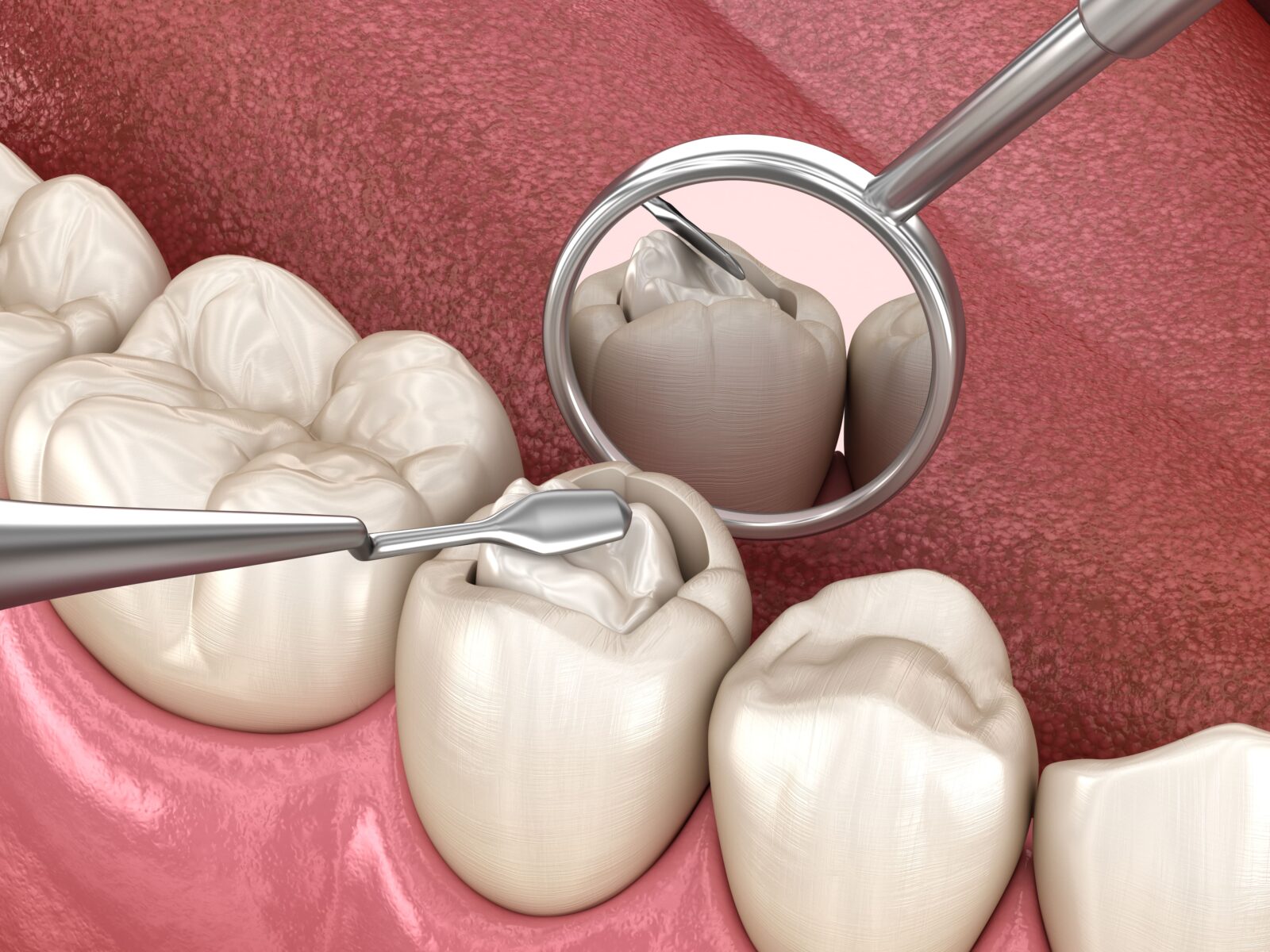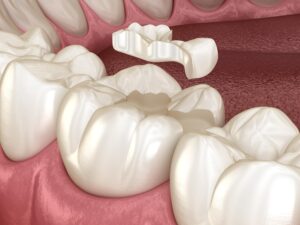Dental fillings are a common procedure used to restore teeth damaged by decay back to their normal function and shape. When a dentist gives you a filling, they first remove the decayed tooth material, clean the affected area, and then fill the cleaned-out cavity with a filling material. But did you know there are different types of fillings? Let’s explore the two main categories: direct and indirect fillings.
Direct Fillings
Direct fillings are applied in a single appointment. The dentist prepares the tooth, places the filling, and adjusts it during your visit. There are several materials used for direct fillings:

- Amalgam: Often known as “silver fillings,” amalgam has been used by dentists for over a century. It’s durable and less expensive than other materials, but because of its dark color, it’s more noticeable than other types of fillings and is not usually used in very visible areas, such as front teeth.
- Composite Resins: These are tooth-colored fillings designed to match the color of your teeth. Composite resins are preferable for people who desire a more natural look. They bond to the tooth to provide additional support but may not be ideal for large fillings as they can chip or wear over time.
- Glass Ionomer: This type of filling is made from acrylic and a specific type of glass material. It releases fluoride, which can help protect the tooth from further decay. However, glass ionomer is less durable than composite resin and is more commonly used in small fillings or below the gum line.
Direct fillings are a straightforward and efficient procedure often completed in a single dental visit. The process begins with the dentist numbing the area around the affected tooth to ensure comfort. Once the area is numb, the dentist removes the decayed tooth material using specialized dental tools. This step is crucial to prevent further decay and prepare the tooth for the filling. After removing the decay, the dentist thoroughly cleans the cavity to eliminate bacteria and debris.
The next step involves the actual filling of the cavity. The dentist selects a filling material—commonly amalgam, composite resin, or glass ionomer—based on the tooth’s location, the extent of decay, and the patient’s preference. The chosen material is then carefully applied to the cavity. For composite resins, a special light is used to harden the material layer by layer, ensuring a firm bond and a durable fill. Finally, the dentist shapes and polishes the filling to ensure a comfortable and natural fit within the mouth.
The result is a restored tooth that can withstand the forces of chewing and feels like a natural part of the dental structure. This procedure not only restores the tooth’s functionality but also prevents further decay and maintains oral health.
Indirect Fillings
Indirect fillings are more complex and require at least two visits. They are used when a tooth has moderate to severe decay or insufficient tooth structure to support a filling but is not so damaged that it needs a crown. Types of indirect fillings include:

- Inlays and Onlays: These are made in a dental laboratory and then cemented or bonded to the tooth during a second visit. Inlays and onlays are made from various materials, including gold, porcelain, or composite resin. Inlays fit within the cusps of the tooth, while onlays cover one or more cusps or the entire biting surface.
- Temporary Fillings: These are not meant to last. They are used in emergency situations or when a patient requires more than one appointment to complete treatment.
Indirect fillings, which include inlays and onlays, are a more intricate procedure than direct fillings and typically require at least two dental visits to complete. In the first visit, after administering a local anesthetic, the dentist removes the decay or old filling material from the damaged tooth, similar to the direct filling process. Precision is key in this step as the dentist needs to create enough space for the indirect filling while preserving as much healthy tooth as possible.
Once the tooth is prepared, an impression of the tooth (and surrounding teeth) is taken. This impression is then sent to a dental laboratory where the inlay or onlay is custom-made using materials such as gold, porcelain, or composite resin. The choice of material often depends on the location of the tooth, the extent of the damage, and aesthetic considerations. While the permanent inlay or onlay is being crafted, a temporary filling is placed to protect the tooth.
During the second visit, this temporary filling is removed, and the dentist checks the fit of the newly fabricated inlay or onlay. Adjustments are made as necessary to ensure a perfect fit and bite alignment. Once the fit is confirmed, the inlay or onlay is bonded to the tooth with a strong adhesive and polished, resulting in a restored tooth that blends seamlessly with the natural teeth, both functionally and aesthetically. This two-step process ensures a high level of precision and durability, making indirect fillings a preferred choice for more extensive tooth restorations.
Choosing the Right Filling for You
The decision on which type of filling to use is a nuanced one, where dentists consider several critical factors to ensure the most effective and long-lasting treatment for their patients. Primarily, the choice depends on the extent of tooth decay or damage; for small to moderate cavities, direct fillings like composite resins or amalgam are often sufficient, while larger areas of decay or fractures may necessitate indirect fillings such as inlays or onlays.
The location of the tooth plays a significant role as well—front teeth or visible areas usually call for tooth-colored materials like composite resins for aesthetic reasons. Additionally, patient-specific factors such as allergies to certain materials, the patient’s oral hygiene habits, and even economic considerations can influence the decision. For instance, while amalgam is more affordable and durable, some patients prefer the more natural look of composite resins despite the higher cost.
The dentist also considers the longevity and wear resistance of the material based on the patient’s bite and chewing patterns. By evaluating these aspects, along with discussing preferences and expectations with the patient, dentists are able to choose the most suitable type of filling, balancing functional necessity with aesthetic preference to achieve optimal dental health outcomes.
Conclusion
Understanding the types of fillings can help you make informed decisions about your dental care. Whether you need a direct or indirect filling, modern dentistry offers solutions that are both functional and aesthetic. Remember, the best way to avoid fillings is through regular dental hygiene and check-ups!



